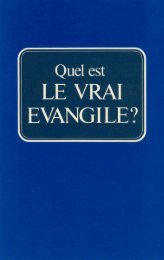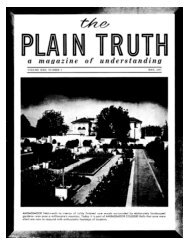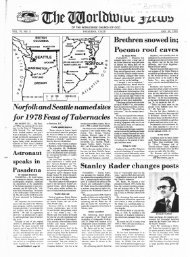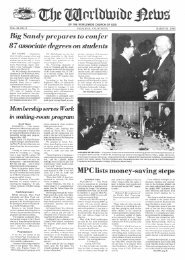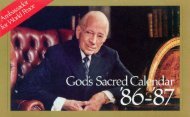The Biblical Basis of the Sacred Calendar Part One
The Biblical Basis of the Sacred Calendar Part One
The Biblical Basis of the Sacred Calendar Part One
Create successful ePaper yourself
Turn your PDF publications into a flip-book with our unique Google optimized e-Paper software.
Which <strong>of</strong> <strong>the</strong> visible astronomical phenomena listed above fit all <strong>of</strong> <strong>the</strong> above criteria?<br />
a) Solar and lunar eclipses;9<br />
b) <strong>The</strong> solstices and equinoxes <strong>of</strong> <strong>the</strong> solar year.<br />
<strong>The</strong> first set <strong>of</strong> "signs" point to two events God wanted man to note: <strong>the</strong> conjunction and <strong>the</strong> opposition <strong>of</strong><br />
<strong>the</strong> sun and <strong>the</strong> moon. <strong>The</strong> second set point to <strong>the</strong> beginnings <strong>of</strong> <strong>the</strong> solar seasons on which human<br />
agriculture depends. (Cf. Deuteronomy 33:15.) Both sets <strong>of</strong> events were measured very carefully by<br />
ancient cultures.<br />
On <strong>the</strong> basis <strong>of</strong> careful observation <strong>of</strong> lunar eclipses in particular, one may calculate not only <strong>the</strong> length <strong>of</strong><br />
<strong>the</strong> mean lunar month, but also <strong>the</strong> timing <strong>of</strong> <strong>the</strong> mean conjunction <strong>of</strong> <strong>the</strong> sun and moon. This latter event<br />
is called <strong>the</strong> molad ("birth [<strong>of</strong> <strong>the</strong> moon]") in <strong>the</strong> Hebrew calendar. Note <strong>the</strong> true conjunction10 may<br />
precede or follow <strong>the</strong> mean conjunction11 by several hours, according to <strong>the</strong> time <strong>of</strong> year. In <strong>the</strong> month <strong>of</strong><br />
Tishri, <strong>the</strong> true conjunction may precede <strong>the</strong> mean conjunction by as much as 14 hours or follow it by up<br />
to six or seven hours.12 In any case, calculations <strong>of</strong> <strong>the</strong> molad must use a mean length for <strong>the</strong> lunar<br />
month, because <strong>the</strong> motions <strong>of</strong> <strong>the</strong> sun and moon are irregular, and because <strong>the</strong> true conjunction is<br />
normally invisible. (This explains in part why a calendar based on observation <strong>of</strong> <strong>the</strong> new crescent is<br />
irreconcilable with one based on calculation <strong>of</strong> <strong>the</strong> molad.)<br />
Solar eclipses, though far more dramatic events (when total) than lunar eclipses, are not nearly as useful<br />
as lunar eclipses for determining ei<strong>the</strong>r <strong>the</strong> length <strong>of</strong> <strong>the</strong> month or <strong>the</strong> timing <strong>of</strong> <strong>the</strong> mean or true<br />
conjunction <strong>of</strong> <strong>the</strong> sun and moon. For one thing, a total solar eclipse is visible only over a small portion <strong>of</strong><br />
<strong>the</strong> earth, and even <strong>the</strong>n is seen by every observer at a different time. <strong>The</strong> chief value <strong>of</strong> solar eclipses to<br />
<strong>the</strong> calendar maker is that <strong>the</strong>y allow him to correct <strong>the</strong> calendar over time for <strong>the</strong> variable rotation <strong>of</strong> <strong>the</strong><br />
earth. (<strong>The</strong> importance <strong>of</strong> this fact will become apparent in <strong>Part</strong> II <strong>of</strong> this series.)<br />
Yet <strong>the</strong> sacred calendar and its festivals are linked to <strong>the</strong> "full moon" (keseh) as well as <strong>the</strong> "new moon" or<br />
chodesh (Psalm 81:3, RSV). Timing <strong>the</strong> heavenly "signs" <strong>of</strong> Genesis 1:14 (in particular, <strong>the</strong> lunar eclipses,<br />
which can be exactly timed over <strong>the</strong> whole night side <strong>of</strong> <strong>the</strong> earth at once) enables one to predict <strong>the</strong><br />
dates <strong>of</strong> future lunar and solar eclipses, and also to calculate <strong>the</strong> mean dates and times <strong>of</strong> <strong>the</strong> new and<br />
full moons for calendrical purposes.<br />
Everyone who has seen moonrise on <strong>the</strong> Night to be Much Observed and <strong>the</strong> first night <strong>of</strong> Tabernacles<br />
may appreciate <strong>the</strong> results <strong>of</strong> such calculations! Abib/Nisan 15 and Tishri 15 coincide in principle with <strong>the</strong><br />
dates <strong>of</strong> mean opposition <strong>of</strong> <strong>the</strong> sun and moon: that is, <strong>the</strong> calendar days <strong>of</strong> <strong>the</strong> full moon. This might not<br />
necessarily be true if <strong>the</strong> months began with <strong>the</strong> new crescent as seen at sunset, Jerusalem time.13<br />
As noted, <strong>the</strong> interval between <strong>the</strong> true conjunction and <strong>the</strong> molad (whe<strong>the</strong>r astronomical or calendrical) is<br />
variable. <strong>The</strong> length <strong>of</strong> <strong>the</strong> calendar month (thanks to <strong>the</strong> length <strong>of</strong> <strong>the</strong> average lunar month) also varies<br />
(between 29 and 30 calendar days). Tishri 1 (for astronomical and religious reasons) may fall locally on<br />
<strong>the</strong> day <strong>of</strong> <strong>the</strong> molad or one or two days after it.14 Finally, for everyone to keep <strong>the</strong> same calendar day all<br />
over <strong>the</strong> world, two full "clock" days must pass for an observer at <strong>the</strong> longitude where <strong>the</strong> calendar day<br />
begins. When <strong>the</strong> Sabbath begins (on Friday at sunset) at our present International Date Line (IDL), it is<br />
still Thursday night in western North America, Hawaii and many South Pacific countries!<br />
Any lunisolar calendar must take into account all <strong>the</strong>se factors and more. <strong>One</strong> may try to do this by<br />
watching for <strong>the</strong> new crescent, and never come up with a sacred calendar that everyone can agree to<br />
follow. Or one may determine <strong>the</strong> beginning <strong>of</strong> <strong>the</strong> months by rules <strong>of</strong> calculation (based on <strong>the</strong> sound<br />
astronomical <strong>the</strong>ory outlined by Genesis 1), and come up with a unified, systematic calendar that works<br />
for everyone, everywhere.<br />
Now it may still "seem right" to some men to define <strong>the</strong> "new moon" as <strong>the</strong> new crescent ra<strong>the</strong>r than <strong>the</strong><br />
mean conjunction. It's not natural for man to trust in something that he cannot see, even in physical




